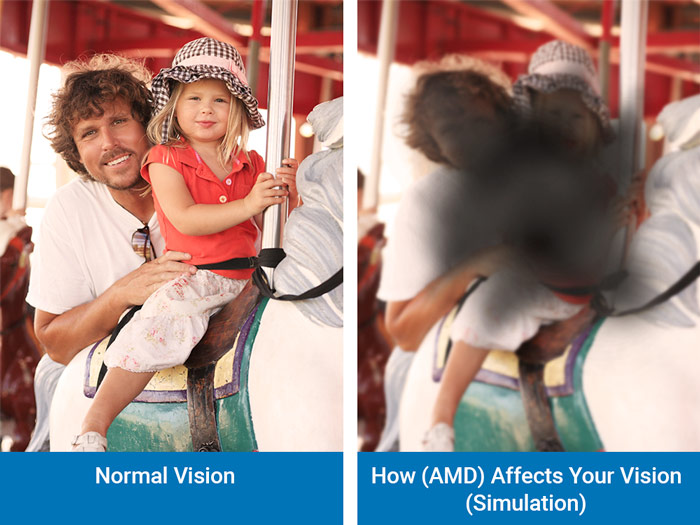Age-Related Macular Degeneration
Early Detection Is Key
Age-Related Macular Degeneration, also known as AMD, is the leading cause of vision loss in adults over the age of 60. In addition, AMD, is the leading cause of blindness in the United States, causing more people to completely lose their vision than cataracts and glaucoma, combined.

What is AMD?
AMD is a disease that affects the retina. The smallest part of the retina is the macula, which is a thin layer of light sensitive tissue that is responsible for sending images to the brain. The retina is located at the back of the eye and is responsible for your sharp, central vision. The macula is the part of our vision that allows you to read, drive, recognize faces and do fine detail work.
There are two types of age-related macular degeneration – dry AMD and wet AMD. While there is no “cure” for AMD, with early intervention and treatment, your vision loss can be significantly reduced.
Dry AMD
Dry AMD is the most common form of macular degeneration and is the beginning stage of the disease. Approximately, 90% of AMD cases are diagnosed as Dry AMD. Dry AMD occurs when the cells in the macula slowly deteriorate when the retinal cells die and are not regenerated. This can occur over several years, many times before vision loss is noticed. Without treatment, Dry AMD can quickly become Wet AMD.
Wet AMD
Wet AMD occurs when abnormal blood vessels grow into the macula. While this is the most advanced type of AMD, it only accounts for about 10% of all cases; however, it is responsible for 90% of blindness caused by AMD.
Wet AMD is when the macula loses oxygen flow, which occurs when the membrane underlying the retina becomes too thick and breaks. The result of a lack of oxygen to the retina is the formation of abnormal blood vessels. These abnormal blood vessels leak and bleed, which causes scarring on the macula. This is what leads to vision loss.
Treatment Options for AMD
There is no cure for AMD, but several treatment options are available to help slow the progression of the disease.
Studies have shown taking a special blend of vitamins can help slow the progression of the disease. These vitamins can be found over-the-counter in most drug stores. The Amsler grid is an at-home test that can help patients monitor the progression of the disease. Patients should look at the Amsler grid daily and immediately call their Waco retina specialist if they notice any distortion or dark/blurred spots that appear in either eye. If either of these appear, bleeding in the retina has likely begun and should be treated immediately.
Wet AMD can be treated by injecting medications into the eye, which will reduce the bleeding and stop the growth of the abnormal blood vessels.
Know the Facts About AMD:
- For adults over age 60, AMD is a leading cause of severe vision loss
- Occurs when portion of the retina, known as the macula, deteriorates
- Early signs: dim, blurry spot in the middle of your vision and may increase in size and become darker as the condition progresses
- There is no cure for AMD but treatments are available to slow the progression of the disease
Everyone is At Risk, Especially:
- Caucasians over the age of 50
- Anyone with a family history of AMD
- Anyone with light-colored eyes
- Diabetics
- Lifestyle factors including smoking, high cholesterol, high blood pressure, and obesity
Schedule An Eye Exam Today
If you have a family history of age-related macular degeneration, or have noticed vision changes, please call Brazos Eye Surgery of Texas today and schedule an eye exam. Early detection can help prevent severe vision loss!
